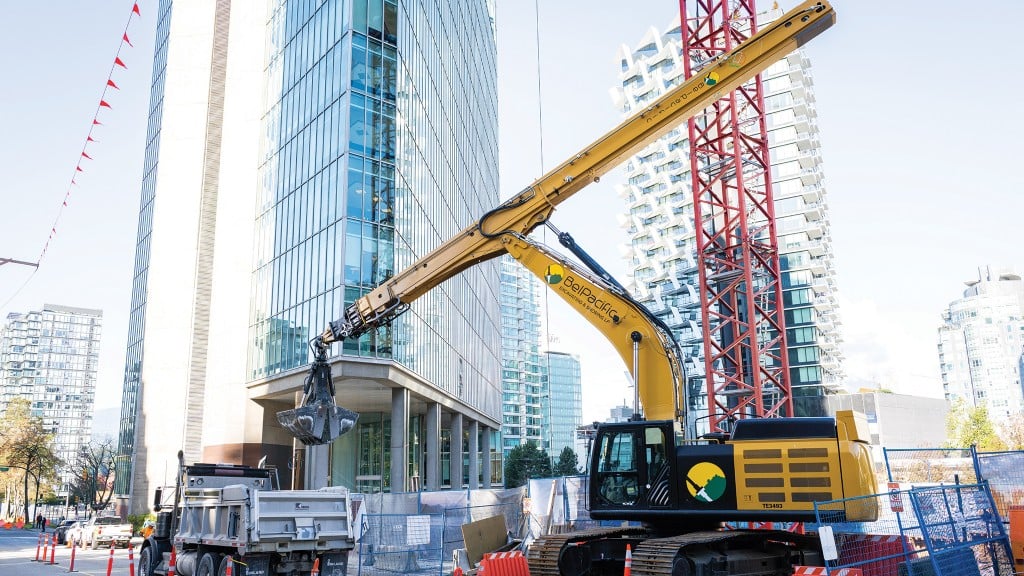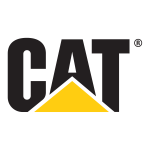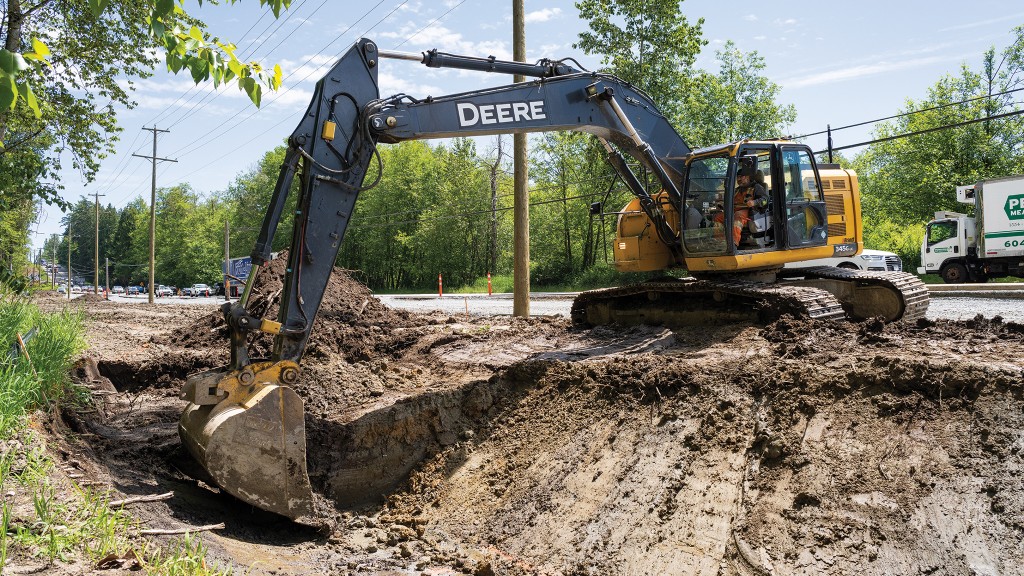The deepest digging excavator in North America
BelPacific Excavating & Shoring LP uses custom-built telestick excavator to excavate 120-foot-deep foundation in downtown Vancouver

BelPacific has a long history of digging deep for projects that have made a significant contribution to the Vancouver, B.C., skyline, completing excavation and shoring work that ranges from 90 to 120 feet deep. These notable landmarks include the Wall Centre, Shangri-La tower, Telus Garden, and The Hudson at 610 Granville in downtown Vancouver, earning BelPacific a reputation as one of the premiere excavation and shoring contractors in Western Canada.
The contractor's latest project, 1515 Alberni Street, took the company to its deepest depth at 120 feet below ground level — a project that required a unique custom-built telestick excavator that delivers the deepest reach in North America.
A strong foundation in B.C.
The company was formed in 1994 after a merger between BEL Contracting and Pacific Blasting. At the time, both companies were competing for market share in the deep excavation space, and it was in the owners' best interests to start a limited partnership. BelPacific Excavating & Shoring LP was created, and operated as part of a group of companies under the NorLand Limited name. When BEL Contracting and Pacific Blasting merged, the combined management team brought 70 years of experience and a wealth of excavating, blasting, and shoring knowledge to the new company, all while continuing to operate with family owned values. The company began to thrive on emerging opportunities in the excavation industry. There weren't many deep excavation contractors at the time, and BelPacific had a majority of the market share. BelPacific colours could be seen on any excavation and shoring job site for residential, commercial, or industrial development in Vancouver.
Since starting out with Caterpillar 235D excavators and air track drills for shoring work, the company has grown to deploy a modern fleet of Caterpillar and John Deere excavators. Today, BelPacific has two main divisions: excavation and shoring/foundation. While the excavation team handles general earthworks on projects, the shoring/foundation division completes drilling, anchoring, micropiles, and shotcrete work.
Architectural legacy in the downtown core
As Vancouver's downtown population has grown over the years to 662,248 people, according to the 2021 Census, the downtown core has densified with larger and taller buildings to accommodate population growth. Developers and architects continue to design taller and more unique high rises to creatively meet the needs of the city.
Downtown Vancouver's newest residential tower development, 1515 Alberni Street, located in Coal Harbour on the corner of Alberni and Nicola Street, will stand tall at 42 storeys boasting 202 residences that provide an inspired alternative to typical urban towers. A team effort between Bosa Properties, Kingswood Properties, Büro Ole Scheeren, and Francl Architecture, the building will be characterized by glass enclosed cantilevers offering a three-dimensional downtown living experience. Nicknamed the "Jenga Tower," its distinctive silhouette will maintain a small footprint at street level with larger protruding three dimensional structures above providing previously unrealized views of the harbour, North Shore mountains, and Stanley Park.
"This is a project I am really proud to be bringing to life as it meets my personal philosophy of quality over quantity," says Lorne Segal, CEO of Kingswood Properties. The 1515 Alberni Street tower is German architect Ole Scheeren's first North American residential building, fulfilling his ambition to reconnect architecture with nature and city surroundings.
Digging deep at 1515 Alberni Street
As high rises have become taller, excavations to accommodate them have become deeper, and 1515 Alberni is no exception — it holds the unofficial record of Vancouver's deepest dig at 120 feet vertical. These deep vertical excavations are primarily for underground parking to meet bylaw requirements based on the number of residences in large urban towers.
On the 1515 Alberni project, BelPacific's scope of work began by partnering with Pacific Blasting & Demolition Ltd, also part of NorLand Limited, to demolish a commercial rental unit building, large water feature, and two and a half levels of parkade. One of the many advantages of NorLand Limited, which includes 12 different companies, is that various divisions can vertically integrate for projects. Deep excavation work in downtown Vancouver can be incredibly challenging; contractors have to navigate adjacent active roadways, ground water, vertical excavation walls, inclement weather, developer schedules, and surrounding high rises.
After the demolition of structures on site, BelPacific began excavation from surface level, excavators worked to remove earth and expose walls on the perimeter of the excavation for drilling, anchoring, and shotcrete work as part of the shoring process. In order to excavate vertically, excavation walls are reinforced or "shored" with long anchor bars, grout, wire mesh, and shotcrete to effectively stabilize and prevent the walls from collapsing inward. As the excavation advances in depth, the process of excavating earth and shoring vertical walls along the perimeter of the excavation is repeated until target depth is achieved. This type of shoring is only temporary until the developer builds the concrete building up against the shored excavation.
On these deep digs, efficiently removing earth from the excavation is key to keeping the project on schedule. In the upper portion of the dig, conventional excavators both excavate and load out material into on-highway trucks. However, as the excavation advances deeper, so do the excavators, which required BelPacific to deploy its long reach excavator, a Cat 336E with a 60-foot arm. Sitting at street level, adjacent to the open excavation and looking over a vertical wall, this machine removed earth stockpiled by excavators within the vertical hole, and loaded tandem axle trucks and pups at street level. Earth excavated from the 1515 Alberni project was exported to a land-based disposal facility by conventional on-highway trucks.
A unique resource for BelPacific is its marine-based disposal facility. If excavated material meets a certain criteria, material exported from site can be sent to a central barge loading facility for disposal at sea by belly dump barges or relocated to another location that could use the material. BelPacific is one of the few deep excavation contractors in Vancouver that has a marine facility, allowing for faster removal of material as trucks don't haul as far compared to land-based disposal facilities.
As the 1515 Alberni dig continued to progress, the long reach soon became ineffective due to its limited reach of 60 feet. To continue excavating material from the project, BelPacific brought in a custom-built Cat 349E L excavator with telescoping stick to excavate material to a final depth of 120 feet below street level.
"Our telescopic excavator's overall performance allowed us to load trucks quickly and efficiently, thanks to the arm's high-speed extension, retraction, and powerful pull-up force," says Richard Christensen, site superintendent with BelPacific Excavating & Shoring LP.
The telescoping stick excavator, or telestick for short, was an instrumental part of the deep dig at 1515 Alberni. With a reach of 35 metres (115 feet), the machine sat adjacent to the vertical excavation. With an internal hydraulic ram it can extend a three-stage stick vertically to scoop up 1.7 cubic yards of loosely piled earth with the stick-mounted clamshell bucket. The stick then retracts, and the excavator swings over to load tandem axle trucks staged in an active laneway. The telestick is the only machine that can reach such depths to excavate material, averaging 400 cubic yards of earth each day. Once the excavation was completed to depth, the excavators that began the excavation at surface level and advanced it vertically downward were craned out. Overall, the 120-foot-deep excavation took a total of 15 months, removing 80,0000 cubic yards of earth to excavate for eight levels of parkade including elevator core and other building footings.
Customized excavator key to project success
BelPacific's customized telestick excavator is the deepest-reaching machine in North America. The decision to build a telestick excavator hinged off the reality that many of BelPacific's projects are becoming deeper and require unique solutions to excavate material. Prior to building this telestick, BelPacific had rented a smaller Cat 336 excavator with telescoping stick for projects such as The Butterfly, a 57-storey luxury tower on the corner of Nelson and Burrard Street in Vancouver.
BelPacific's telestick features a Cosben TA-3550 three-stage telescopic arm reaching 35 metres (115 feet). This set-up was installed onto a Cat 349E L excavator by Van-Ed Equipment, the dealer for Cosben products in Western Canada. Cosben SRL, an engineering and manufacturing company based out of Italy, is well-known for telescoping stick excavator attachments with some capable of reaching 42 metres (138 feet). The units are designed to be strong, lightweight, safe, and offer fast cycle times, making them ideal in these demanding deep excavation projects.
The Cat 349E L was prepped by removing the OEM stick and bucket, then Van-Ed Equipment installed the Cosben TA-3550 at its Port Kells facility in Surrey. The primary scope of work included installing the high- and low-flow hydraulic circuits for telescoping arm functions and clamshell bucket rotation respectively, Cosben wiring harness and control box, and hydraulic quick connects between the clamshell bucket and the telescopic arm.
An interesting safety feature was included in this work: Caterpillar OEM lock valves for the boom and stick cylinders. These valves lock the hydraulic cylinder in the event of a hydraulic system failure, such as a ruptured hydraulic hose. BelPacific's Cat 349E L was also modified to accept the Cosben unit, receiving an additional 4,500 pounds of counterweight to balance the excavator when fitted with the telestick. This counterweight was designed and fabricated in-house by Van-Ed Equipment. Additionally, a secondary hydraulic tank known as a "surge tank" was added to accommodate the higher volume of hydraulic oil required by the telescoping arm. This was again designed and built in-house by Van-Ed and adapted to work in conjunction with the Caterpillar OEM hydraulic tank.
For added visibility when excavating over a vertical edge, Van-Ed Equipment installed a Brigade Electronics Elite HD Camera with sound capability mounted to the telescoping arm, and a 7-inch monitor in the cab. Once all the modifications were completed, Van-Ed Equipment carried out on-site testing and calibration, in addition to safety and operational training sessions for BelPacific operators. The telestick was an instrumental component to BelPacific's success at 1515 Alberni Street, reaching 120 feet below street level to excavate material, a task no other machine was capable of.
Well positioned for the next big dig
The 1515 Alberni Street project is just a taste of where the deep excavation market is headed in the coming decade as high rises get taller and larger, requiring deeper excavations to accommodate levels of parking and building structural components. BelPacific's Cat 349 telestick excavator will be an essential tool, helping the company take on deeper digs than its competitors are capable of. With 30 years in the business of digging deep in Vancouver, a fleet of modern equipment, and a talented team of people in both the field and office, BelPacific Excavating & Shoring LP is well positioned as Vancouver ushers in a new era of high-rise building construction to meet the demands of a growing population.
Mack Plovie is the president and chief dirt enthusiast of Earthmovers Media Group.







